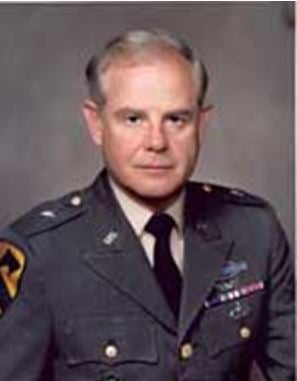- Brigadier General
- Korea & Vietnam
Biography
Brigadier General Richard S. Sweet was a native of Cranston, Rhode Island and a 1947 graduate of Cranston High School. He entered the Rhode Island State College (now the University of Rhode Island) in the fall of 1947 and enrolled in the Army ROTC program. In 1951, he graduated from URI with a Bachelors of Science Degree in Business Administration and was commissioned as a Second Lieutenant of Infantry.
First Lieutenant Sweet served in the Korean War as a Platoon Leader and Company Commander in the 279th Infantry Regiment, 45th Division. His bravery and leadership were outstanding. He continued to motivate and care the soldiers in his unit. He graduated from the Infantry School in 1957 and then graduated from the U.S. Army Command and General Staff College in 1964. He received a Master’s Degree in Business Administration the following year from Syracuse University
In February 1968, Lieutenant Colonel Sweet was the Battalion Commander of the 2d Battalion, 12th Cavalry, 1st Air Cavalry Division. His unit was conducting combat operations in vicinity of Hue, South Vietnam when the North Vietnamese Army launched its famous Tet offensive into South Vietnam. Lieutenant Colonel Sweet distinguished himself by exceptionally valorous actions and heroism. Lieutenant Colonel Sweet was on the ground with his front-line troops when the enemy launched an attack on the city.
Positioning himself far forward, he disregarded the intense North Vietnamese mortar and sniper fire and expertly directed his forces in an advance toward Hue. His brilliant leadership enabled all four of his companies to cross a wide-open rice paddy successfully into the city while under a constant enemy fusillade. In his book The Lost Battalion of Tet, author Charles A. Krohn describes the series of events during 3-5 February 1968 when Lieutenant Colonel Sweet led his encircled battalion through heavy enemy resistance, under a steady hail of mortar and heavy automatic weapons fire from three sides to retain a critical position. Subsequently, the battalion’s perimeter came under extremely heavy bombardment and, shortly thereafter, began receiving ground attacks by large numbers of North Vietnamese soldiers. Lieutenant Colonel Sweet skillfully directed the perimeter defense, personally encouraging his troops’ fight.
After dark, Lieutenant Colonel Sweet devised a plan to deceive the surrounding North Vietnamese forces and move through their positions to a new location deeper in their lines of communication. The entire battalion slipped through the enemy’s encirclement without suffering one casualty. Lieutenant Colonel Sweet’s example provided the inspiration for his troops; and by daybreak, they had successfully occupied commanding terrain deep inside the enemy’s area of operations. For his actions during 3-5 February 1968, Lieutenant Colonel Sweet was awarded the Distinguished Service Cross.
In 1970, after serving in the Vietnam War, Lieutenant Colonel Sweet graduated from the U.S. Army War College. In 1973-74, Colonel Sweet was the Commanding Officer of the 1st Brigade, 9th Infantry Division at Fort Lewis, Washington. The next year he worked at the US Army Recruiting Command as Chief of Staff in Fort Sheridan, Illinois.
In 1975-76, he served as Deputy Director for Accession and Retention at the Office of the Secretary of Defense. His last Pentagon assignment as a Brigadier General was as Assistant Deputy Chief of Staff for personnel. He retired from the military in 1978. From 1978 to 1980, he was Deputy Administrator for Manpower at the Veterans Administration. He formed a consulting business, Sweet and Associates, in 1983.
Brigadier General Sweet’s extraordinary heroism and devotion to duty were in keeping with the highest traditions of the military service and reflect great credit upon himself, his family and the University of Rhode Island.
Brigadier General Richard S. Sweet died 24 July 1994 at Walter Reed Army Hospital. He was buried with full military honors in Arlington National Cemetery, Arlington, Virginia.
Education
1951

